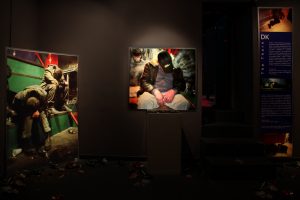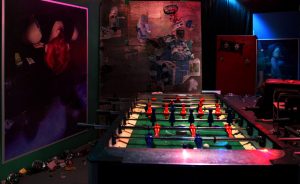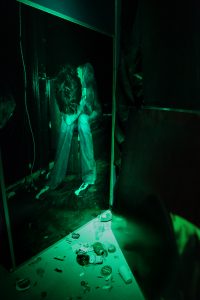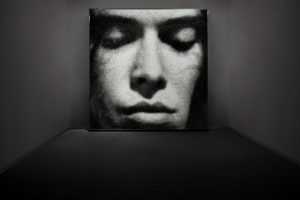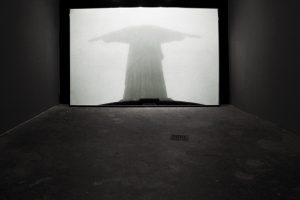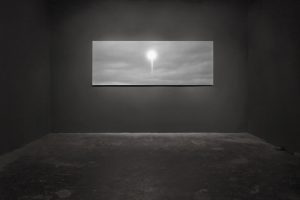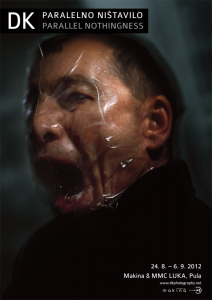 Razstava / Exhibition
Razstava / Exhibition
Odprtje: petek, 24. avgust, 2012 ob 21. uri
Opening: Friday, 24th of August, 2012 at 9 pm
Lokacija / Location: Galerija Makina & MMC Luka, Pula, Croatia
Paralelno ništavilo
»Razvoj fotografiranja, od njegovih početaka do danas, proces je sve većeg osvješćivanja pojma informacije: od želje da svaki put koristimo uvijek istu metodu, do zanimanja za uvijek nove metode.«1
Već letimičan pogled kroz dugogodišnji opus fotografa, koji se obično predstavlja inicijalima DK, otkriva da se radi o jednom od onih autora koji u svojem stvaranju ne bježe od uvijek novih, međusobno prilično različitih kreativnih metoda. Štoviše, u slučaju DK-a upravo se »zanimanje za uvijek nove metode« pojavljuje kao nezaobilazni čimbenik pri razvijanju konceptualnih okvira autorovih serija koje se u pravilu oblikuju u širim vremenskim etapama. Tako neke ostaju još nedovršene i svojim raznovrsnim karakterima ukazuju na široki spektar stvarateljevih interesa na području autorske fotografije.Istaknuta heterogenost autorova opusa odslikava što raznovrsnije sadržajne registre koji se kreću od verizma dokumentarističkih na jednom (serija Trn/The Thorn), pa sve do insceniranih, krajnje metaforičkih modaliteta na drugom polu (serija Svjedočenja/Testimonies). Stoga DK-ov opus kao cjelinu karakterizira čitav niz gotovo paralelnih narativa čiji presjek, odnosno zajednički nazivnik treba najčešće tražiti u autorovom sofisticiranom odazivu na događanja u široj društvenoj stvarnosti koja sa svojim turbulentnim dinamizmom ne zahtijeva samo dinamične refleksije te vrste, već i redovito mijenjanje točaka gledišta, a paralelno s tim i samih metoda stvaranja. Unatoč mjestimice nepodnošljivoj neposrednosti, njegovi vizualni zapisi ipak u pravilu ostaju suptilni, interpretacijsko otvoreni, a ponegdje čak i krajnje zagonetni. Jačina njihove sadržajne fleksibilnosti omogućuje tumačenja na različitim razinama, što je u pažljiva gledatelja u stanju izazvati čitav niz asocijativnih zaključaka.
Vratimo li se uvodnom Flusserovom citatu, možemo uz autorovo traženje, koje godinama prelazi u različite faze promjena i sazrijevanja, isto tako promišljati i o osvješćivanju konkretnog fotografskog djela kao informacije. Autorove fotografije nesumnjivo su nekakve bilješke njegovih susreta sa svijetom – dakle, još uvijek su to informacije o interakcijama, o autorovu subjektivnom shvaćanju, osjećanju i promišljanju svijeta. Ali fotografa pritom toliko ne zanima konkretna, nazovimo je dokumentarna vrijednost uhvaćenog trenutka, kao što ga zanima distancirani, gotovo već otuđeni izraz koji sadržava onu rijetku i dragocjenu kvalitetu, pomoću koje se može razapeti u univerzalističku bezvremenost te se stoga i poigrati s neiscrpnom mrežom značenja. Dakle, čini se da se internalizirano, u sebe usmjereno traženje i razmišljanje o slikama koje posjeduju vrijednost za obuhvaćanje nekakvog totaliteta svijeta, odnosno iskustva života u njemu, ne mora nužno odvijati na razinama empirijskog i opisnog – fotografija kao informacija postaje izrazita svjedokinja neposrednog subjektivnog iskustva (serija Silent), postaje medij autorova emocionalnog rasuđivanja, čime se DK seli i u koordinate koje snaga racionalnog ne može više prikladno definirati. Pomoću slika iz spomenute serije, koje se kreću prema fantastičnom, odnosno apstraktnom – a kao cjelina nesumnjivo predstavljaju jedan od vrhunaca njegova rada – fotograf si zadaje gotovo neizvedivi zadatak: vizualnu verbalizaciju nesvjesnog, pa čak i mističnog. Time fotografija postaje svjedokom traženja apsolutnog, postaje alat za bilježenje transcendentalnog, a pomoću svoje poetičnosti pokušava obuhvatiti i nekakvu cjelokupnost egzistencijalnog iskustva. Ali pritom autor cijelo vrijeme održava razumnu, zdravu distancu; kao što je zapisao i sam DK: »Fotografiranje stvara potrebu za iskustvom udaljenosti i razgraničenja između mene i objekta. S ‘realistične’ estetike prelazim na estetiku ‘distance’.«2Korištenjem svojeg bogatog metierskog znanja, DK uvijek ostaje izrazito dosljedan i strog: izrezi, kompozicije, tonaliteti boja i vješta primjena (kontrastne) svjetlosti ukazuju na autora koji, posvećujući se sadržaju, nikako ne zanemaruje likovne strane svojeg rada. Kao što sam kaže, fotografija mora odražavati suvremenost, a da se pritom ne odriče klasičnog. Dojam koji ostavljaju njegove fotografije najviše se približuje monumentalnom (posebice u seriji Lice/The Face i Svjedočenja/Testimonies) – ovakvo predstavljanje forme ukazuje na autorovu namjernu upotrebu referenci onih tamnih razdoblja dvadesetog stoljeća kada je umjetnost na neposredan i otvoren način služila određenim ideološkim ciljevima. Čini se da su formalni naglasci ovoga tipa ovaj put usmjereni prije svega prema komunikaciji s gledateljem, prema jasnoći i izravnosti autorove materijalizirane vizije koja mora učinkovati što direktnije, ikonično i punoznačno.
Uzbudljiv izbor fotografija s kojima se DK predstavlja na dvije izložbe u Puli iznova dokazuje da se u njegovu slučaju može govoriti o jednoj od zanimljivijih autorskih pozicija u suvremenoj slovenskoj fotografiji. »[Fotografija] je trag. Ona je svjedok (moje) egzistencije,«3 zapisuje autor. Radilo se o portretima Metelkovaca i poznatih muzičara, o scenama sa životinjama ili malaksalih noćnih skitnica, o metaforičkim ekskurzima na područja mistične tišine ili teritorije sukoba – DK ostaje vjeran vlastitom kredu koji je posvećen angažiranom i beskompromisnom preispitivanju svijeta, vlastitog položaja u njemu, a naposljetku i samog medija fotografije. »DK istražuje temeljno pitanje: možemo li u današnjem svijetu, koji je ionako prezasićen slikama radi njihovog mnoštva, pomoću fotografije napraviti nešto više? Može li fotografija biti još uzbudljiva, transcendentna?«, pita se u predgovoru autorove monografije dr. Marina Gržinić.4 Odgovor je, naravno, na dlanu.
Matjaž Brulc
—
1 Vilém Flusser, Filozofija fotografije, Scarabeus naklada, Zagreb 2007, Prijevod: Daniela Tkalec
2 Sažeto po autorovom vlastitom tekstu (Artist’s Statement). Naglasci su autorovi.
3 Ibid.
4 Marina Gržinić, DK: Vse – in še več, objavljeno u DK – Prehajanja k modernim skrbem, Strip Core/Forum Ljubljana i Mestna galerija Ljubljana, Ljubljana 2008.
Parallel Nothingness
“The evolution of photography, from its origins right up to the present, is a process of increasing awareness of the concept of information: from an appetite for the continually new using the same old method to an interest in continually evolving new methods.”1
Even a cursory glance at DK’s body of work, spanning a number of years, reveals that he is an artist who is not afraid of using new and different creative methods. DK’s interest in continually evolving new methods is an inescapable element in the development of conceptual frameworks for his series, which generally take shape over long periods of time. Some thus remain incomplete and, through their diverse characters, showcase the wide spectrum of his interests in photography.
The accentuated heterogeneity of his work reflects the immensely varied content registers that move from a verism of documentary modalities at the one end of the range (the series The Thorn) to staged, entirely metaphorical ones at the other (the series Testimonies). His entire body of work is thus characterised by an array of almost parallel narratives whose common denominator must be often sought in the artist’s sensitive reaction to events in wider social reality. Its turbulent dynamics call for not only an equally dynamic reflexion, but a consistent shifting of perspectives, and, simultaneously, the very methods of creation. Despite their sometimes unbearable straightforwardness, his visual records nevertheless remain generally subtle, open to interpretation and, at times, even curiously enigmatic. The degree of flexibility in their content enables interpretation at various levels, which evokes an abundance of associative conclusions in an attentive observer.
Inspired by Flusser’s introductory quote, one may ponder the increasing understanding of a photograph as a piece of information in light of the artist’s quest, which has experienced transitions to various stages of change and maturity over the course of years. Without doubt, his photographs are a sort of note on his encounters with the world – they remain bits of information about interactions, about his subjective understanding, sensation of, and reflection on the world. However, the photographer is less interested in the tangible – call it the documentary value of the moment captured if you will – and more in the distanced, almost foreign expression, which inherently carries the rare and valuable quality of being able to straddle universalistic timelessness and, as a consequence, simultaneously play with an inexhaustible network of meanings.
And so it seems that the internalised search for and reflection on the images that can encompass a totality of a world or the experience of life in it no longer takes place at the empirical or descriptive levels – a photograph as a piece of information becomes an explicit witness of a direct subjective experience (the series Silent), a medium of the artist’s emotional reasoning, thereby moving DK to coordinates that cannot be adequately defined by the power of the rational. Through the images from this series, displaying fantastic and abstract tendencies,a culmination of his work if considered as a whole, the photographer takes on a daunting task: visual wording of the unconscious, even mystical. The photograph becomes a testament to the pursuit of the absolute, a tool for recording the transcendental, and seeks to encompass a totality of a life experience by way of its poetic character. Nevertheless, DK has a constant grip on a reasonable distance. As he himself states, “to photograph is to experience distance and separation between myself and the object. I move away from a ‘realistic’ aesthetics towards an aesthetics of ’distance’.”2
When applying the wealth of his savoir-faire, DK remains highly consistent and strict: frames, compositions, colour tonality, and the skilful use of (contrastive) lighting attest to an artist who never neglects the visual layer of his work when focusing on the subject matter. As he himself states, a photograph must reflect the contemporary without being divested of the classical. The impression his photographs convey is frequently close to monumental (particularly in the series The Face and Testimonies). Such representations of the form point to the artist’s intentional use of references from the dark eras of the twentieth century, when art directly and openly served specific ideological objectives. It seems that these accentuations allude to a communication with the viewer, clarity and directness of the artist’s materialised vision, which must produce as direct, as iconic and as fully semantic an effect as possible.
The exciting selection of photographs displayed at two exhibition venues in Pula testifies once more to one of the most intriguing stances in modern Slovenian photography. ”Photography is a trace. It is a testament of (my) existence,”3 he writes. Whether it is portraits ofactivists of the alternative scene at Metelkova in Ljubljana, renowned musicians, animals or fatigued night owls, metaphorical digressions into mystical silence or territories of conflict, DK remains faithful to his own creed, dedicatedly engaged and uncompromising reasoning of the world, his own position within it and, finally, the very medium of photography. “DK explores the fundamental questions: Can we possibly do anything more with photography in the prevailing world already tired of images, for they are much too profuse? Can photography still be contradictory, or transcendent?” Marina Gržinić wonders in the foreword to the artist’s book.4 Needless to say, the answer is evident.
Matjaž Brulc
—
1 Vilém Flusser, Towards a Philosophy of Photography, Reaktion Books Ltd, London 2005, p. 59. Translated by Anthony Mathews.
2 Summarised from the artist’s text (Artist’s Statement). The emphases are in the original.
3 Ibid.
4 Marina Gržinić, “DK – Everything and more”, published in DK – Passages to modern concerns, Strip Core/Forum Ljubljana & Mestna galerija Ljubljana, Ljubljana, 2008, pg. 11.

